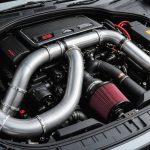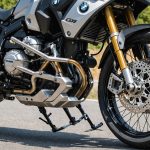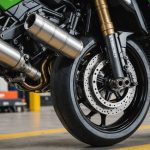Understanding ABS and Its Importance
The Anti-lock Braking System (ABS) is a pivotal technology in the world of motorcycles, offering a significant boost in safety and control. By preventing wheel lock-up during braking, ABS enhances stability. This is particularly crucial when riding the Kawasaki ZX-10R, as its high performance demands precise handling.
ABS performance on the ZX-10R ensures that riders maintain traction even in sudden stop situations, reducing the risk of skidding. This safety feature is invaluable when navigating through wet or slippery conditions. The system’s ability to seamlessly modulate brake pressure allows for a more controlled and confidence-inspiring ride, enabling riders to focus on the thrill of the road while knowing they have a safety net in place.
Also read : Step-by-Step Guide: How to Tighten Spokes on Your BMW F750GS for Enhanced Performance
Moreover, the integration of ABS on the Kawasaki ZX-10R enriches the overall riding experience. Riders can take advantage of the motorcycle’s capabilities without the constant worry of potential brake failures. This technology not only protects the rider but also extends the lifespan of the bike’s braking system by minimizing wear and tear. Aided by ABS, the ZX-10R melds adventurous performance with essential safety, offering riders an unparalleled riding experience.
Regular Maintenance to Ensure Optimal ABS Functionality
For motorcycle enthusiasts eager to relish the ride, routine ABS maintenance significantly enhances safety. Begin with scrutinising brake fluid quality; poor fluid hinders ABS responsiveness. Regular changes are essential, ideally annually, or every 20,000 kilometres. This simple task ensures your system performs optimally, preventing corrosion and maintaining hydraulic efficiency.
In the same genre : Step-by-Step Guide to Replacing Front Fork Seals on Your Kawasaki Ninja H2
Routine checks of the ABS’s sensors and electronic components are imperative. Sensors, which read wheel speed, must remain free from debris or damage. Clean them gently and inspect connections for corrosion. If sensors are compromised, the ABS might misinterpret braking needs, raising safety risks.
In addition to sensor upkeep, ensure the Electronic Control Unit (ECU) functions correctly. A functional ECU processes sensor data to modulate braking pressure efficiently. When troubleshooting, check ECU error codes with diagnostic tools. These codes can reveal faults, enabling timely fixes and avoiding expensive repairs.
Beyond these tasks, consider including motorcycle upkeep basics like tire inspections. Tires affect the ABS’s performance; unbalanced or worn tires can lead to inaccurate readings. Proper inflation and tread depth are non-negotiable for both routine riding and emergency stops. Following these maintenance practices keeps your ABS system finely tuned, offering a safer ride.
Adjusting ABS Settings for Improved Performance
Fine-tuning the ABS settings on your Kawasaki ZX-10R can greatly enhance your riding experience. To access and modify the ABS settings, locate your bike’s Control Unit Interface. Typically, this is done via the onboard diagnostics port or through specific handlebar controls, depending on the model year. This accessible system allows for precise performance tuning tailored to your personal preferences and riding conditions.
Different riding environments require specific adjustments to maximise braking efficiency and handling. For wet roads, a softer ABS setting is often recommended to improve grip and prevent wheel lock-up. Conversely, on dry and smooth tracks, firmer settings are advantageous, offering you more control and sharper braking response.
Kawasaki ZX-10R adjustments can significantly influence how the motorcycle handles. A well-calibrated ABS enhances stability during abrupt stops, minimising the risk of skidding. This not only boosts confidence but ensures safer riding across varied terrains. By carefully tuning these settings, riders can enjoy a balanced synergy between power and safety, enabling optimal performance from the ZX-10R. Adjustments should be made patiently, testing each configuration until the desired handling is achieved.
Troubleshooting Common ABS Issues
Understanding ABS troubleshooting for your ZX-10R can save time and ensure a safe ride. Let’s explore some ways to identify and address common problems.
Recognizing signs of ABS malfunction is crucial. Usual indicators include the ABS warning light staying illuminated, unusual noises when braking, or a change in brake response. These signs suggest a requirement for further diagnostic techniques.
Riders may encounter issues like sensor misalignment or damaged wiring, often influencing ABS function. A sensor misalignment might occur due to hard impacts or routine wear and tear. In such cases, checking sensor positioning and ensuring it’s free from debris is essential. Damaged wiring, meanwhile, might cause inconsistent brakes, demanding attention from more technologically savvy riders.
If basic diagnostic techniques don’t resolve the problems, seeking professional assistance is advisable. Mechanics can employ advanced diagnostic tools to address these more elusive issues. Faulty ABS modules or complex electronic failures require professional expertise to prevent further complications.
Riders should rely on professional help when problems persist despite troubleshooting efforts, ensuring safety and reliability remain uncompromised during rides. By proactively addressing these concerns, riders can maintain their bikes in peak condition, promoting a safer riding experience.
Riding Techniques to Enhance ABS Effectiveness
Integrating Anti-lock Braking Systems (ABS) with proper riding techniques can significantly improve a rider’s safety. Using braking techniques that complement ABS ensures maximum efficiency in preventing wheel lock-up. Start by maintaining a firm grip on the handlebars while applying steady pressure to the brake lever. This helps the ABS to modulate braking force effectively, preventing skidding. When approaching a stop, a smooth and gradual squeeze of the brakes engages the ABS more efficiently than abrupt braking.
Stay aware of your surroundings by practising situational awareness. Constantly scan the road for potential hazards like wet patches or debris, adjusting your speed accordingly. This proactive awareness is crucial for ABS performance, allowing you to brake safely under adverse conditions.
Safety tips for ABS include regularly testing the system to ensure it functions correctly, especially before a long ride. Maintaining control is key, so avoid panic. Trust the ABS to do its job. Remember, ABS is a tool—effective rider control and awareness remain essential. Engaging your ride with these techniques will build confidence, ensuring a safer and more enjoyable experience on the road.
Visual Resources for ABS Optimization
Visual guides and instructional videos can significantly enhance one’s understanding of ABS optimization for motorcycles like the ZX-10R. These resources bring concepts to life, making complex topics more accessible and engaging.
Benefits of Visual Aids
Visual aids are incredibly effective for comprehending the application of ABS. They cater to different learning styles, allowing users to see the process in action and better grasp the nuances involved. Videos, in particular, provide real-time demonstrations, which can clarify intricate processes that might be difficult to understand through text alone.
Recommended Video Tutorials
For ZX-10R owners, specific video tutorials are invaluable. Several online platforms offer detailed, step-by-step guides on optimizing ABS settings for this particular model. Watching experts in action can provide practical insights, helping riders to implement the techniques on their own bikes confidently.
Using Reference Materials Effectively
To maximise learning, it’s essential to combine visual guides with other reference materials. This integrated approach enhances understanding and retention. By pausing videos and referring to written manuals, learners can digest and implement information more effectively. Whether one is a novice or an experienced rider, these visual resources are fantastic tools for optimizing ABS technology.











